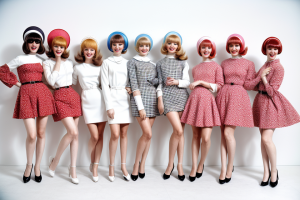
Fashion is a dynamic industry that has witnessed numerous trends and styles over the years. From Coco Chanel to Gianni Versace, the world of fashion has been graced by some of the most iconic designers in history. But who among them can be considered the greatest of all time? This is a question that has been debated by fashion enthusiasts and experts alike. In this article, we will delve into the world of fashion and explore the contenders for the title of the greatest fashion designer of all time. From their unique design philosophies to their lasting impact on the industry, we will examine the contributions of some of the most influential figures in fashion history. So, let’s get ready to embark on a journey through the world of fashion and discover who truly revolutionized the industry.
Defining Greatness in Fashion Design
Criteria for evaluating greatness
Innovation and Originality
Innovation and originality refer to the designer’s ability to introduce new ideas, techniques, and designs that challenge conventional fashion norms. This includes pushing boundaries with unconventional materials, unique silhouettes, and daring design choices. The degree to which a designer can consistently create original work that sets them apart from their peers is a crucial factor in determining their greatness.
Impact on the Fashion Industry
The impact of a designer on the fashion industry can be measured by their influence on trends, style, and the overall direction of the industry. A great designer can spark a revolution in fashion, inspiring new designers and shaping the aesthetic of an era. They may also leave a lasting mark through their work at prominent fashion houses or through their own eponymous label.
Influence on Popular Culture
A designer’s influence on popular culture extends beyond the fashion industry. They may have an impact on art, music, film, and even social movements. Their designs may become iconic symbols of a particular era or movement, and their personal style may be emulated by celebrities and influencers. A designer’s ability to transcend the boundaries of fashion and become a cultural icon is an important aspect of evaluating their greatness.
Longevity and Enduring Relevance
The longevity and enduring relevance of a designer’s work is a testament to their greatness. A truly great designer’s work will stand the test of time, remaining relevant and influential for decades or even centuries after its creation. This includes the ability to adapt to changing trends and styles while maintaining a distinct and recognizable aesthetic. The designer’s ability to sustain their legacy and continue to inspire future generations of designers is a key factor in evaluating their greatness.
Subjective nature of fashion greatness
- Personal preferences and cultural context:
- Fashion greatness is subjective and varies based on individual preferences and cultural context.
- Factors such as age, gender, socioeconomic status, and cultural background can influence one’s perception of great fashion design.
- What one person considers to be great design may not be the same for another.
- Evolving trends and changing tastes:
- Fashion trends and tastes are constantly evolving, making it difficult to define greatness in a static manner.
- A design that was once considered great may no longer be seen as such due to changes in fashion trends and tastes.
- Greatness in fashion design is not static but rather dynamic, constantly evolving with the times.
- Different styles and design movements:
- The definition of greatness in fashion design is also influenced by the different styles and design movements that have emerged over time.
- For example, a designer may be considered great within the context of a particular design movement, but their work may not be as highly regarded in another context.
- Therefore, the concept of greatness in fashion design is multifaceted and can be influenced by various factors.
The role of subjectivity in the search for the greatest designer
In the search for the greatest fashion designer of all time, it is essential to recognize the role of subjectivity. Personal perspectives and opinions play a crucial role in determining who is considered the greatest. Each individual’s experiences and cultural background shape their tastes and preferences, leading to diverse opinions on who is the best designer.
It is important to acknowledge that fashion is a form of self-expression, and what one person considers great may not be the same for another. For example, someone who values minimalism and simplicity may appreciate the designs of a modernist designer, while someone who favors extravagance and opulence may prefer the works of a designer known for their ornate and lavish creations.
Moreover, personal experience also plays a significant role in shaping one’s opinion on fashion design. An individual’s upbringing, cultural background, and experiences can all influence their taste and preferences, making it difficult to objectively determine who the greatest designer is.
However, despite the subjective nature of fashion, it is crucial to recognize the value of diverse tastes and styles. Fashion is a reflection of society, and it is essential to celebrate and embrace the diverse perspectives and opinions that make it unique. The search for the greatest designer should not be about finding a single, objective truth but rather about appreciating the many different perspectives and opinions that contribute to the rich tapestry of fashion.
Pioneers of Fashion Design
Coco Chanel
Coco Chanel was a pioneering fashion designer who revolutionized women’s fashion with her innovative designs and timeless style. She was born in 1883 in Saumur, France, and began her career as a singer and actress before turning to fashion design.
One of Chanel’s most significant contributions to fashion was her introduction of the “little black dress,” which became a staple of women’s wardrobes around the world. She also popularized the use of jersey knit fabric, which was previously considered a utilitarian material for men’s clothing. Chanel’s use of jersey knit in women’s fashion marked a significant departure from the more traditional fabrics like silk and lace that were commonly used at the time.
Chanel’s designs were characterized by their simplicity, elegance, and sophistication. She was known for her use of classic shapes and lines, which allowed women to look chic and stylish without having to wear overly ornate or fussy clothing. Her designs were also often inspired by menswear, which helped to break down gender barriers in fashion and pave the way for a more modern, gender-neutral approach to dressing.
In addition to her innovations in women’s fashion, Chanel had a significant impact on society as a whole. She was a strong-willed and independent woman who challenged traditional gender roles and societal expectations. She was also a trailblazer in the business world, building her fashion empire from humble beginnings to become one of the most successful and influential designers of the 20th century.
Today, Chanel’s legacy continues to inspire and influence designers around the world. Her iconic designs and timeless style have become synonymous with luxury and sophistication, and her influence on the fashion industry can still be felt today.
Christian Dior
Christian Dior, born in 1905, was a French fashion designer who revolutionized the fashion industry with his eponymous brand. His innovative designs and visionary approach to fashion helped shape the industry and established him as one of the most influential designers of the 20th century.
New Look and the post-war fashion revolution
In 1947, Christian Dior presented his first fashion collection, known as the “New Look.” This collection featured voluminous skirts, cinched waists, and nipped-in waists, which marked a dramatic departure from the masculine, utilitarian styles of the 1940s. The New Look was an instant hit and was widely credited with revitalizing the post-war fashion industry. It signaled a return to femininity and glamour, and the style was embraced by women around the world.
Haute couture and ready-to-wear
Christian Dior was one of the first designers to establish a ready-to-wear line, which made his designs more accessible to a wider audience. However, it was his haute couture collections that cemented his reputation as a master couturier. Dior’s haute couture designs were characterized by their intricate details, exquisite craftsmanship, and attention to detail. He was known for his use of luxurious fabrics, such as silk, velvet, and lace, and his designs often featured elaborate embroidery and beading.
Dior’s influence on contemporary fashion
Christian Dior’s influence on contemporary fashion cannot be overstated. His designs have inspired countless fashion designers, and his legacy continues to be felt in the fashion industry today. Many of the fashion industry’s most iconic and influential designers, including Yves Saint Laurent, Gianni Versace, and Marc Jacobs, have cited Dior as a major influence on their work. Dior’s emphasis on femininity, elegance, and sophistication continues to shape the fashion industry, and his designs remain timeless and relevant today.
Giorgio Armani
- Pioneering modern minimalism
- Elegance and understated sophistication
- The Armani brand and its global reach
Giorgio Armani, an Italian fashion designer, is widely regarded as one of the greatest designers of all time. He has been a pioneer in modern minimalism, and his designs are renowned for their elegance and understated sophistication.
Armani’s approach to fashion design is characterized by simplicity and the absence of excess. He has developed a unique style that is distinct from other designers, focusing on clean lines, classic silhouettes, and the use of high-quality materials. His designs are not only aesthetically pleasing but also functional, with an emphasis on comfort and versatility.
Armani’s influence on the fashion industry has been immense. He has created a global brand that encompasses multiple lines, including menswear, womenswear, accessories, and beauty products. The Armani brand is synonymous with luxury and is known for its attention to detail, quality, and innovation.
Armani’s influence extends beyond the fashion industry. He has collaborated with numerous celebrities, including Hollywood stars and sports personalities, and has been involved in the design of costumes for various films and stage productions. Armani’s impact on popular culture is significant, and his designs have become iconic, often referenced in film, television, and music.
In conclusion, Giorgio Armani’s contribution to the world of fashion has been remarkable. He has revolutionized the industry with his unique approach to design, and his influence is felt worldwide. Armani’s commitment to simplicity, elegance, and quality has inspired generations of designers, and his legacy will continue to shape the future of fashion.
Yves Saint Laurent
Revolutionizing fashion with the “Museo” dress
In 1971, Yves Saint Laurent made fashion history with his iconic “Museo” dress. The design featured a shift from the conventional feminine silhouettes of the 1960s and 1970s, with its straight-cut and narrow-defined waist. This innovative design, inspired by the art and architecture of ancient civilizations, offered women a more comfortable and practical alternative to the voluminous, restrictive garments of the era. The “Museo” dress symbolized a significant turning point in fashion, paving the way for modern, versatile wardrobe staples that remain popular today.
Groundbreaking collections and designs
Throughout his career, Yves Saint Laurent consistently pushed the boundaries of fashion, presenting collections that redefined the aesthetic landscape. In 1983, his “Mademoiselle Libération” collection featured power suits, reinterpreting traditional men’s attire for women. This daring move challenged societal norms and inspired a generation of women to embrace a more androgynous, professional style. Additionally, Saint Laurent’s use of ethnic and cultural influences in his designs, such as his African-inspired collection in 1968, demonstrated his commitment to celebrating diversity and breaking down barriers in fashion.
YSL’s impact on fashion and society
Yves Saint Laurent’s revolutionary designs not only transformed the fashion industry but also had a profound impact on society. By introducing a broader range of silhouettes and fabrics, he made fashion more inclusive and accessible to a wider audience. Saint Laurent’s innovative designs encouraged self-expression and individuality, inspiring countless designers and shaping the future of fashion. Furthermore, his unwavering commitment to craftsmanship and quality elevated the status of haute couture, cementing his position as one of the greatest designers of all time.
The Criteria Applied
Innovation and originality
Designs that changed fashion history
Fashion has a long and storied history, and certain designs have stood the test of time and continue to inspire designers today. These iconic designs are often the result of a designer’s ability to innovate and push boundaries, and they have left an indelible mark on the fashion industry. For example, the little black dress, created by Coco Chanel in the 1920s, is still a staple of any fashionable woman’s wardrobe, and its simplicity and versatility have made it a timeless classic.
Pushing boundaries and challenging conventions
In order to truly revolutionize fashion, designers must be willing to take risks and challenge the status quo. This often involves pushing boundaries and challenging conventional wisdom, which can be a daunting task. However, those who are willing to take on this challenge are often rewarded with innovative and groundbreaking designs that leave a lasting impact on the fashion industry. For example, the avant-garde designs of designer Alexander McQueen were known for their boldness and willingness to push the boundaries of what was considered fashionable.
Embracing new technologies and materials
Innovation in fashion is not just about design, but also about the materials and techniques used to create clothing. Designers who are willing to embrace new technologies and materials are often able to create unique and innovative designs that set them apart from their peers. For example, designer Hussein Chalayan is known for his use of cutting-edge materials and techniques, such as laser cutting and 3D printing, to create unique and avant-garde designs.
Overall, innovation and originality are essential components of a successful fashion designer. Those who are able to push boundaries, challenge conventions, and embrace new technologies and materials are often the ones who leave the most lasting impact on the fashion industry.
Impact on the fashion industry
Transforming the industry with new trends and styles
In the world of fashion, a designer’s ability to create and popularize new trends and styles is paramount to their success. A great designer should be able to identify and capitalize on emerging trends, and translate them into wearable and desirable clothing. This requires a deep understanding of consumer preferences, an eye for detail, and the ability to innovate and take risks.
Establishing new standards and benchmarks
A great designer should also be able to establish new standards and benchmarks for the fashion industry. This means creating designs that push the boundaries of what is considered fashionable and desirable, and inspiring others to follow in their footsteps. A truly great designer should be able to create a unique and recognizable style that sets them apart from their peers, and which influences the direction of the industry as a whole.
The influence of a designer’s work on other designers
Finally, a great designer should be able to influence and inspire other designers. This means creating designs that are not only visually stunning, but also technically sound and innovative. A great designer should be able to inspire others to push the boundaries of fashion and design, and to create clothing that is not only beautiful, but also meaningful and relevant to contemporary society.
Influence on popular culture
- Fashion as a reflection of cultural values and identity
- The relationship between fashion and culture
- How fashion can reveal a society’s values and beliefs
- The role of fashion in preserving cultural heritage
- The role of fashion in shaping society and vice versa
- Fashion as a tool for social change
- The impact of fashion on consumer behavior and social norms
- The influence of fashion on technology and industry
- Designers who have left a lasting cultural impact
- The legacy of pioneering designers like Coco Chanel and Christian Dior
- The impact of designers on global fashion trends
- The influence of designers on other creative industries, such as film and music.
Longevity and enduring relevance
Designers who have created timeless pieces that continue to be relevant and sought after for decades, if not centuries, possess a unique quality that sets them apart from their contemporaries. The fashion industry is built on the idea of change and novelty, but certain designers have managed to transcend these trends and create works that stand the test of time.
The power of classic designs lies in their ability to be both timeless and timely. A classic design can be adapted and remixed, keeping it fresh and relevant while still maintaining its original essence. The enduring relevance of a designer’s work is a testament to their ability to create pieces that are not only aesthetically pleasing but also functionally practical and emotionally resonant.
Longevity in the fashion industry is a rare quality, and it is often associated with designers who have managed to establish a recognizable and cohesive aesthetic. A designer’s ability to maintain a consistent vision over the course of their career is a significant factor in their enduring relevance.
Furthermore, a designer’s impact on the industry and their influence on future generations of designers is also a key factor in determining their longevity. Designers who have shaped the fashion industry and left a lasting legacy are those who have pushed boundaries, challenged conventions, and created new aesthetic languages.
In conclusion, longevity and enduring relevance are crucial criteria in the search for the greatest designer of all time. Designers who have created timeless pieces that continue to be relevant and sought after for decades, if not centuries, possess a unique quality that sets them apart from their contemporaries. The power of classic designs lies in their ability to be both timeless and timely, and a designer’s ability to maintain a consistent vision over the course of their career is a significant factor in their enduring relevance.
The Contenders
Gianni Versace
Gianni Versace, an Italian fashion designer, founded his eponymous brand in 1978. He quickly made a name for himself with his innovative designs and glamorous, celebrity-inspired collections. Versace’s rise to fame coincided with the 1990s, a decade marked by the emergence of supermodels like Naomi Campbell, Cindy Crawford, and Linda Evangelista. Versace’s designs, characterized by their bold prints, bright colors, and daring silhouettes, became synonymous with the era’s glamour and extravagance.
Miami Vice and the rise of 90s supermodels
Versace’s impact on fashion during the 1990s can be attributed, in part, to his collaboration with the hit television series Miami Vice. The show’s lead actors, Don Johnson and Philip Michael Thomas, frequently wore Versace-designed suits, introducing the brand to a wider audience and solidifying its status as a symbol of luxury and style. This exposure helped establish Versace as a go-to designer for celebrities and the fashion-conscious elite, paving the way for the rise of 1990s supermodels.
Celebrity-inspired designs and red carpet glamour
Versace’s penchant for designing glamorous, celebrity-inspired looks led to the creation of some of the most iconic red carpet dresses in history. The brand’s most famous creation is likely the safety-pin dress worn by model Naomi Campbell on the cover of Time magazine in 1995. The dress, inspired by the theme of “Golden Age of Cinema,” featured thousands of safety pins that created an intricate, mesh-like pattern. This groundbreaking design cemented Versace’s reputation as a master of red carpet glamour and established Campbell as a fashion icon.
Versace’s legacy after his untimely death
Gianni Versace was tragically murdered outside his Miami mansion in 1997. Despite his untimely death, his legacy continues to influence the fashion industry. Versace’s sister, Donatella, took over as creative director, steering the brand towards a more mature and sophisticated aesthetic. Today, Versace remains a revered fashion house, known for its bold, sexy, and unapologetically opulent designs. The Versace brand has also expanded into home furnishings, fragrances, and beauty products, further solidifying its position as a lifestyle brand.
Karl Lagerfeld
Creative Director of Multiple Fashion Houses
Karl Lagerfeld was not only the creative director of Chanel, but also held the same position at Fendi and his own eponymous fashion house. This made him one of the few designers to helm multiple major fashion brands simultaneously. His influence extended far beyond these labels, as he also collaborated with various other fashion houses and luxury brands.
Fashion’s “Most Important Man” According to WWD
In 2011, WWD (Women’s Wear Daily) declared Karl Lagerfeld the “most important man in fashion.” This title was not given lightly, as Lagerfeld had been a major force in the industry for over four decades. He had revolutionized the fashion world with his unique and unconventional designs, as well as his ability to stay ahead of trends and set new ones.
Lagerfeld’s Vision and Impact on Contemporary Fashion
Karl Lagerfeld’s impact on contemporary fashion cannot be overstated. He was known for his bold and innovative designs, which often featured a mix of classic and modern elements. He was also famous for his signature look, which included a black suit, white shirt, and dark glasses. His designs were worn by some of the most famous and influential people in the world, cementing his status as one of the most important designers of the 20th and early 21st centuries.
Ralph Lauren
Ralph Lauren is an American fashion designer, philanthropist, and businessman, known for his innovative and timeless designs. Over the years, he has established himself as one of the most influential designers in the fashion industry, creating a brand that epitomizes All-American luxury and preppy chic.
Expansion into Fragrances, Home Decor, and Hospitality
In addition to his eponymous fashion line, Lauren has expanded his brand into various other industries, including fragrances, home decor, and hospitality. In 1978, he launched his first fragrance, “Ralph Lauren,” which has since become an iconic scent, and he has continued to create successful fragrances for both men and women.
In 1983, Lauren opened his first store outside of New York City, in Chicago, and he has since expanded his retail empire to include over 500 stores worldwide. He has also ventured into the hospitality industry, opening the chic and stylish Ralph Lauren-designed restaurant, The Polo Bar, in New York City in 1997.
Global Appeal of Ralph Lauren’s Brand
Lauren’s brand has a global appeal, with a strong presence in both the United States and Europe. His designs are known for their classic and timeless appeal, making them popular among consumers of all ages and backgrounds. In 2019, Forbes estimated his net worth at $7.5 billion, making him one of the richest people in the fashion industry.
Overall, Ralph Lauren’s impact on the fashion industry cannot be overstated. He has created a brand that is synonymous with luxury and sophistication, and his designs continue to inspire and influence the industry to this day.
Donna Karan
Donna Karan, an American fashion designer, is known for her urban chic designs and her contribution to the rise of “dressing for success.” Her designs in the 1970s and 1980s featured body-conscious silhouettes that emphasized a woman’s curves, which made her a fashion icon of the era.
- Urban chic and the rise of “dressing for success”
Karan’s designs were inspired by the urban lifestyle of the 1970s, which emphasized simplicity, comfort, and versatility. Her clothing was designed to be practical and stylish, with an emphasis on clothes that could be worn to work or for other professional settings. Karan’s designs helped to popularize the concept of “dressing for success,” which encouraged women to dress in a way that reflected their professional aspirations.
- Seventies-inspired designs and body-conscious silhouettes
Karan’s designs in the 1970s and 1980s were characterized by their simplicity, versatility, and focus on the female form. Her use of bold colors, patterns, and textures helped to create a distinctive style that was both feminine and powerful. Karan’s designs featured body-conscious silhouettes that emphasized a woman’s curves, which helped to create a new standard of beauty and femininity.
- The influence of Karan’s designs on contemporary fashion
Karan’s designs have had a lasting impact on contemporary fashion. Her urban chic aesthetic has influenced the designs of many other fashion designers, and her focus on the female form has helped to create a new standard of beauty and femininity. Karan’s designs have also influenced the way that women dress for work and other professional settings, helping to create a more inclusive and diverse fashion industry.
Tom Ford
- Gucci’s turnaround and Ford’s rise to fashion stardom
- In the 1990s, Tom Ford was appointed as the creative director of Gucci, a brand that was struggling at the time.
- Ford’s vision and design aesthetic revitalized the brand, leading to a dramatic turnaround and making Gucci one of the most successful and recognizable luxury fashion brands in the world.
- Ford’s leadership and design talent earned him a reputation as one of the most influential designers of his generation.
- The return of Ford to the fashion world with his eponymous label
- After leaving Gucci, Ford launched his own eponymous fashion label in 2006.
- The label quickly gained critical acclaim and commercial success, with Ford’s designs consistently praised for their sophistication, glamour, and attention to detail.
- Ford’s brand has become synonymous with luxury and elegance, and his designs are coveted by fashion lovers around the world.
- Ford’s vision of glamour and sophistication
- Ford’s designs are characterized by their bold, sexy, and sophisticated aesthetic.
- He is known for his use of luxurious materials, intricate details, and striking colors, which he combines in a way that is both elegant and edgy.
- Ford’s designs are not only beautiful, but they also convey a sense of confidence and power, making his customers feel like they can take on the world.
- Ford’s influence on the fashion industry cannot be overstated, and his designs continue to inspire and influence fashion lovers and designers alike.
The Debate
The role of personal taste and cultural context
Personal taste and cultural context play a significant role in determining one’s perception of fashion greatness. These factors can influence how an individual views a designer and their work.
- How different people may view the same designer differently: Personal taste can lead to differing opinions about a designer’s work. Some may appreciate the innovative and avant-garde designs of a particular designer, while others may find them too outlandish or unwearable. This subjectivity can make it difficult to determine a single “greatest” designer.
- The impact of individual experiences and backgrounds on perceptions of greatness: Cultural context also plays a significant role in shaping perceptions of fashion greatness. Individual experiences and backgrounds can influence one’s understanding and appreciation of a designer’s work. For example, someone from a particular cultural background may be more likely to appreciate designs that reflect their cultural heritage.
- The role of subjectivity in determining fashion greatness: The debate around the greatest designer of all time is largely subjective. There is no objective measure of fashion greatness, and different individuals may have different criteria for what constitutes great design. Some may prioritize technical skill and innovation, while others may value comfort and wearability. This subjectivity makes it difficult to determine a single, definitive answer to the question of the greatest designer of all time.
The challenge of comparing different designers and their contributions
Different design movements and eras
Comparing designers across different time periods presents a significant challenge due to the unique contexts and design movements that have shaped each era. For example, the Haute Couture designs of the 1920s and 1930s, characterized by their extravagance and glamour, would be difficult to compare with the minimalist and functional designs of the 1990s. Understanding the specific context in which each designer worked is crucial to evaluating their contributions to the fashion industry.
The diversity of styles and aesthetics in fashion
Another challenge in comparing designers is the vast array of styles and aesthetics that have emerged throughout fashion history. From the draped silk gowns of the 1920s to the streetwear-inspired designs of today, fashion has embraced a multitude of aesthetics and design elements. This makes it difficult to compare designers across different styles, as their contributions may be more readily apparent within the context of their particular style.
The importance of context when evaluating designers’ impact
In addition to considering the time period and style of each designer, it is also important to consider the broader context in which they worked. This includes the social, cultural, and economic factors that influenced their designs and the impact they had on the fashion industry. For example, a designer’s contributions may be more significant when considered within the context of a particular social movement or cultural shift.
Overall, comparing different designers and their contributions to the fashion industry is a complex task that requires a thorough understanding of the unique contexts and styles that have shaped each era. By taking these factors into account, we can begin to evaluate the impact of each designer and their place in the history of fashion.
The case for and against each contender
Christian Dior
- Strengths:
- Revolutionized fashion with the creation of the “New Look” in 1947, featuring a voluminous silhouette and bold use of fabric.
- Established the house of Dior, which became a symbol of luxury and elegance.
- Influenced numerous designers and fashion trends throughout his career.
- Weaknesses:
- Limited creative output due to his untimely death in 1957.
- Criticisms of his designs being overly conservative and catering to a narrow clientele.
Coco Chanel
+ Pioneered a more practical and functional approach to fashion, challenging traditional norms.
+ Created iconic pieces such as the little black dress and the Chanel suit.
+ Built a successful fashion empire that remains influential to this day.
+ Some argue that her designs lacked the artistic and avant-garde qualities of other contenders.
+ Criticisms of her use of unpaid or underpaid labor during World War II.
Giorgio Armani
+ Established a global luxury brand known for its minimalist, modern, and versatile designs.
+ Recognized for his innovative use of materials and attention to detail.
+ Continued relevance and success in the contemporary fashion industry.
+ Some critics argue that his designs lack the dramatic impact and artistic vision of other contenders.
+ Controversy surrounding his business practices and treatment of workers.
Karl Lagerfeld
+ Creative director for multiple fashion houses, including Chanel and Fendi, showcasing his versatility and innovation.
+ Recognized for his daring and unconventional designs, pushing the boundaries of fashion.
+ A prolific designer with a significant influence on contemporary fashion.
+ Criticisms of his commercialized approach to fashion, prioritizing marketability over artistic integrity.
+ Controversies surrounding his public persona and personal life.
Gianni Versace
+ Established a globally recognized brand known for its bold, sexy, and daring designs.
+ Innovative use of materials and design elements, often incorporating Greek and Roman motifs.
+ Continued influence on contemporary fashion, particularly in the realm of celebrity and luxury wear.
+ Criticisms of his designs being overly commercial and lacking in depth or substance.
+ Controversies surrounding his personal life and involvement in the fashion industry's excesses.
Yves Saint Laurent
+ Revolutionized fashion with his contributions to the bohemian, ethnic, and gender-fluid styles of the 1960s and 1970s.
+ Established a successful fashion house that continues to influence contemporary designers.
+ Known for his skillful adaptation of historical and cultural references in his work.
+ Criticisms of his later designs being less innovative and relying too heavily on past successes.
+ Controversies surrounding his personal life and mental health.
The debate over the greatest fashion designer of all time involves evaluating each contender’s strengths and weaknesses, considering controversial opinions, and weighing the importance of multiple perspectives. The discussion is enriched by the unique contributions and legacies of each designer, highlighting the diverse ways in which they have revolutionized fashion.
FAQs
1. Who is considered the greatest fashion designer of all time?
The question of who is the greatest fashion designer of all time is subjective and depends on personal opinions and criteria. Some people may consider Coco Chanel, Christian Dior, or Yves Saint Laurent as the greatest designers due to their significant contributions to the fashion industry and their lasting impact on fashion trends.
2. What criteria are used to determine the greatest fashion designer of all time?
Criteria for determining the greatest fashion designer of all time may include their impact on the fashion industry, their innovation and creativity, their longevity and influence, and their ability to create timeless and iconic designs.
3. Who are some of the most influential fashion designers of all time?
Some of the most influential fashion designers of all time include Coco Chanel, Christian Dior, Yves Saint Laurent, Gianni Versace, Giorgio Armani, and Ralph Lauren. These designers have had a significant impact on the fashion industry and have shaped the way people dress and think about fashion.
4. What are some of the most iconic designs by the greatest fashion designers of all time?
Some of the most iconic designs by the greatest fashion designers of all time include Coco Chanel’s little black dress, Christian Dior’s New Look, Yves Saint Laurent’s Le Smoking suit, Gianni Versace’s safety pin dress, Giorgio Armani’s men’s suits, and Ralph Lauren’s polo shirt. These designs have become synonymous with the designers who created them and have had a lasting impact on fashion.
5. How has the search for the greatest fashion designer of all time evolved over time?
The search for the greatest fashion designer of all time has evolved over time as new designers emerge and as the fashion industry changes. What was once considered the pinnacle of fashion design has changed as society’s values and priorities have shifted. The search for the greatest fashion designer of all time is an ongoing conversation that reflects the current state of the fashion industry and its evolving tastes and preferences.







